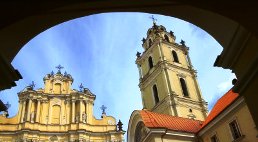
| Education System in Lithuania |
There have been ongoing attempts to upgrade the Lithuanian education system since 2003 and these are nearing completion. Education at all state, non-tertiary institutions is free now, except for pre-school which is partly subsidized. The primary school program takes 4 years to complete, nominally between ages 6 to 11. Some schools specialize in this stage only, while others provide all 3 phases of school education.
From approximately ages 10 to 17 students pursue their 6 years of education at middle school towards their certificate of lower secondary education.The curriculum continues to be mainly academic still.
For their final 2 school years at secondary institutions young adults may continue with general education, or move on to vocational schools that will fit them better for an entry-level job. When the new state model is complete, it will be possible to switch between these two streams.
Adults can complete their secondary education in special classes. Youth schools provide training to troubled pupils with learning or social difficulties. There is a network of vocational colleges offering shorter training courses too. Education is alive in Lithuania these days, after an oppressive winter.
 State and private tertiary institutions are divided into 2 kinds, namely non-university level colleges and true universities. All programs are assessed annually by the Ministry of Education and Science, and there is a national credit system of 1600 hours per year. Moving through bachelors to masters and to doctorates is strictly regulated, and there are no short cuts allowed.
State and private tertiary institutions are divided into 2 kinds, namely non-university level colleges and true universities. All programs are assessed annually by the Ministry of Education and Science, and there is a national credit system of 1600 hours per year. Moving through bachelors to masters and to doctorates is strictly regulated, and there are no short cuts allowed.
The most venerable institution is the University of Vilnius established in 1579 as a Jesuit Academy. Following a violent period of disruption in the latter 20th Century, peace has returned and it has rebuilt its many faculties,